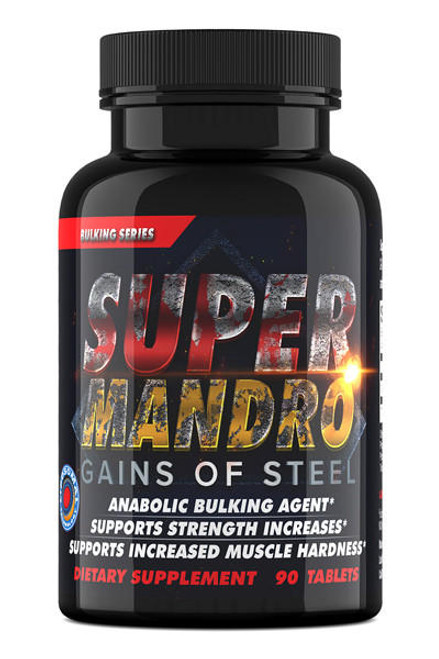The Ultimate Guide to Properly Bulking
Posted by Leonard Shemtob on Apr 04, 2023
The Ultimate Guide to Properly Bulking: Maximize Muscle Growth and Minimize Fat Gain
Introduction
Bulking is a popular approach to increasing muscle mass and strength. This comprehensive guide will provide you with everything you need to know about bulking efficiently and effectively. We will answer common questions, provide tips, and outline strategies for maximizing muscle growth while minimizing fat gain.
The Concept of Bulking Bulking refers to a period of increased calorie consumption and strength training aimed at increasing muscle mass. The objective is to consume more calories than your body needs for maintenance, providing your muscles with additional energy to grow.
How to Bulk Properly
Finding the Right Balance The most efficient way to bulk is to strike a balance between muscle growth and fat gain. This involves managing your calorie intake, maintaining a balanced diet, and incorporating proper strength training.
Monitoring Your Progress
To know if you are bulking correctly, track your body composition, strength gains, and overall progress. Regular check-ins can help you identify if adjustments are necessary.
Bulking Duration
The length of your bulking phase depends on your goals and current physique. Generally, a bulking phase lasts 3-6 months, followed by a cutting phase to shed excess fat.
Meal Frequency for Bulking
While individual preferences vary, eating 4-6 meals per day can support muscle growth and help you consume enough calories.
Fastest Bulking Methods
The fastest way to bulk is to combine a high-calorie diet with a well-designed training program that targets all major muscle groups. However, faster bulking may result in more fat gain.
Bulking for Skinny Individuals
Skinny individuals can benefit from a higher calorie surplus and a focus on compound exercises to promote muscle growth rapidly. See the Blog article How to Bulk Up As A Skinny Guy for more info.
Optimal Bulking Duration for Muscle Growth
Building muscle takes time. A 3-6 month bulking period is typically sufficient for noticeable muscle gains.
The Role of Nutrition in Bulking
Eating a balanced diet rich in protein, carbohydrates, and healthy fats is essential for muscle growth during a bulk.
The Importance of Bulking for Muscle Gain
Bulking can be an effective strategy for increasing muscle mass, as it provides the necessary energy and nutrients for growth.
Bodybuilders and Bulking
Bodybuilders often employ bulking and cutting cycles to maximize muscle growth while minimizing fat gain.
Top Tips for Bulking Success
- Consistently consume a calorie surplus
- Prioritize protein intake
- Focus on compound exercises
- Get adequate sleep
- Monitor your progress
Fastest Muscle-Building Strategies
Combine a high-calorie diet with a well-designed strength training program and ensure adequate rest and recovery for optimal muscle growth.
Bulking Duration for Bodybuilders
Bodybuilders typically bulk for 3-6 months before entering a cutting phase.
Consuming More Calories for Bulking
Incorporate calorie-dense foods, such as nuts, avocados, and whole grains, to increase your calorie intake without feeling overly full.
Eating Frequency
During a Bulk Aim for 4-6 meals per day, evenly spaced throughout the day, to support consistent energy intake and muscle growth.
The 5,000-Calorie Diet
A 5,000-calorie diet may be appropriate for individuals with high energy demands, such as professional athletes. Prioritize nutrient-dense foods and ensure balanced macronutrient intake.
Foods to Support Muscle Growth
- Lean protein sources (chicken, turkey, fish)
- Whole grains (brown rice, quinoa)
- Healthy fats (avocado, nuts, olive oil)
- Fruits and vegetables

Quick Bulking Strategies
To bulk up quickly, focus on consuming a higher calorie surplus, prioritize protein intake, and engage in a well-designed strength training program.
Seven-Day Bulking Plan
While significant muscle growth is unlikely in just one week, you can kickstart your bulking journey by establishing a consistent eating and training routine.
- Bulking Diet Essentials
- High-quality protein sources
- Complex carbohydrates
- Healthy fats
- Fruits and vegetables
- Adequate hydration
Initiating a Bulking Phase
To start bulking, determine your maintenance calorie intake, establish a calorie surplus, and develop a strength training program tailored to your goals.
The Necessity of Bulking for Muscle Gain
While bulking is not the only way to gain muscle, it can be an effective approach for providing the necessary energy and nutrients for muscle growth.
Training Considerations
During a Bulk Focus on compound exercises that target multiple muscle groups, maintain a consistent training schedule, and allow for adequate rest and recovery.
Best Practices for Rapid Bulking
Combine a high-calorie diet with an effective strength training program, ensure adequate sleep, and monitor your progress to optimize muscle growth.
Bulking Timelines
The time it takes to bulk up varies depending on individual factors, such as genetics, training experience, and adherence to diet and training programs.
Bulking Down
Transitioning to a Cutting Phase After completing a bulking phase, transition to a cutting phase by reducing your calorie intake and incorporating cardiovascular exercise to shed excess fat.
Preparing for a Bulk
Before beginning a bulking phase, assess your goals, determine your calorie needs, and develop a training plan tailored to your objectives.
Two-Week Bulking Plan
While significant muscle growth is unlikely in just two weeks, you can establish a consistent eating and training routine to lay the foundation for future gains.
Training for Bulking
Focus on compound exercises, progressively increase resistance, and allow for adequate rest and recovery to promote muscle growth during a bulk.
The Most Important Aspect of Bulking
Maintaining a consistent calorie surplus and engaging in effective strength training are crucial components of a successful bulking phase.
Dirty Bulking vs. Clean Bulking
Dirty bulking involves consuming a large calorie surplus, often from unhealthy food sources, while clean bulking focuses on a moderate surplus from nutrient-dense foods. Clean bulking is generally a healthier and more sustainable approach.
Essential Elements of a Successful Bulk
- Consistent calorie surplus
- Balanced macronutrient intake
- Effective strength training program
- Adequate rest and recovery
Supplements for Bulking
Consider incorporating supplements such as protein powder, creatine, and branched-chain amino acids (BCAAs) to support muscle growth during a bulk.
It's important to remember that supplements should be used to complement a well-rounded diet and training program, not replace them. Before adding any supplements to your routine, consult with a healthcare professional or registered dietitian to ensure they are appropriate for your needs and goals.
Protein Powder: Consuming adequate protein is essential for muscle growth. Protein powders, such as whey protein, casein, or plant-based options, can help you reach your daily protein goals more easily and serve as a convenient post-workout recovery drink. You can measure your grams of protein in the Protein Intake Calculator Here.
Creatine: Creatine is a well-researched supplement known for enhancing muscle strength, power, and size. It increases the availability of phosphocreatine in the muscles, which helps to produce more energy during high-intensity workouts. Aim for 3-5 grams per day during your bulking phase. A great creatine supplement is Creatine by Psycho Pharma:
Branched-Chain Amino Acids (BCAAs): BCAAs, consisting of leucine, isoleucine, and valine, play an important role in muscle protein synthesis and recovery. While they can be obtained from protein-rich foods, BCAA supplements can be a convenient option, especially for pre- and post-workout nutrition.
Beta-Alanine: Beta-alanine is a non-essential amino acid that can help buffer lactic acid in the muscles, potentially improving endurance and reducing muscle fatigue during intense workouts. Aim for 3-6 grams per day, taken in smaller doses to minimize tingling sensations.
Fish Oil: Rich in omega-3 fatty acids, fish oil can support overall health and reduce inflammation, promoting better recovery during your bulking phase. Aim for 1-3 grams of combined EPA and DHA per day.
Pre-Workout Supplements: Pre-workout supplements often contain ingredients such as caffeine, beta-alanine, and citrulline malate, designed to improve energy, focus, and endurance during workouts. Choose a reputable product and follow the manufacturer's recommended dosage. Strongs go to Pre Workouts include, Oracle by Olympus Labs, Seismic Surge by HR Supplements, Wild Thing by Assault Labs, Bucked Up and Alpha Lion SuperHuman Pre. You can also see the Top 10 Pre Workout Article for more info.
Weight Gainer Shakes: For individuals struggling to consume enough calories through whole foods, weight gainer shakes can be a convenient way to increase calorie intake. Look for products with a balanced macronutrient profile and minimal added sugars.
Bulking Muscle Mass Builders - Strong Supplement Shop has a wide array of Bulking supplements that help to build muscle mass and give you the best result on your bulking process. Strong has a Top 10 Bulking Supplements Ranked article where you can see the best bulking supps on the market today. Here is a preview of some of the best supplements for adding muscle mass.
- Anafuse by Vital Alchemy
- AlphaBulk by Olympus Lab
- Colossal Muscle by Hard Rock Supplements
- Super Mandro by Hard Rock Supplements
- Andro the Giant by Hard Rock Supplements
Body Fat
While bulking, some increase in body fat is often unavoidable due to the calorie surplus required to support muscle growth. However, there are strategies to help minimize unnecessary fat gain during a bulking phase:
Moderate Calorie Surplus: Aim for a moderate calorie surplus of about 250-500 calories per day, depending on your individual needs and goals. This will provide enough energy to support muscle growth without causing excessive fat gain.
Prioritize Protein: Ensure you're consuming adequate protein to support muscle growth and recovery (approximately 0.8-1.0 grams per pound of body weight). Protein also has a higher thermic effect, meaning your body burns more calories digesting it compared to carbohydrates and fats.
Focus on Nutrient-Dense Foods: Choose whole, minimally processed foods that are rich in vitamins, minerals, and fiber. These foods will help support overall health and promote a more favorable body composition during your bulk.
Foods to Avoid During a Bulk
Limit foods high in added sugars and unhealthy fats, as they can contribute to excessive fat gain and negatively impact overall health.

Strategies for Successful Bulking Phase
- Track your progress
- Adjust your diet and training sessions as needed
- Remain patient and consistent
- Focus on long-term goals
Determining Your Ideal Bulking Duration
Consider factors such as your starting physique, goals, and personal preferences when determining the length of your bulking phase.
- Foods for Rapid Bulking (Diet Tips)
- Calorie-dense options (nuts, seeds, avocados)
- High-quality protein sources (lean meats, fish, dairy)
- Complex carbohydrates (whole grains, starchy vegetables)
Gaining 15 Pounds Quickly
While rapid weight gain may not be entirely muscle, a combination of a high-calorie diet and effective strength training can help you gain weight quickly. However, be aware that faster weight gain may result in more fat accumulation.
Setting Realistic Bulking Expectations While rapid muscle growth may be enticing, it's essential to set realistic expectations and understand that muscle growth takes time, dedication, and consistency.
The Role of Genetics in Bulking Genetics can play a role in your ability to gain muscle, influencing factors such as muscle fiber composition, hormone levels, and metabolic rate.
Bulking for Women
Women can also benefit from bulking phases to increase muscle mass, focusing on a moderate calorie surplus and a well-designed strength training program.
The Importance of Recovery During a Bulk
Adequate sleep and rest days are crucial for muscle repair and growth during a bulking phase, ensuring you maximize the benefits of your training.
Adjusting Your Bulk
Based on Progress Regularly assess your progress and make adjustments to your diet and training as needed to maintain a steady rate of muscle growth while minimizing fat gain.
Dealing with Plateaus During a Bulk If you encounter a plateau during your bulk, consider increasing your calorie intake, adjusting your training program, or incorporating deload weeks to allow for recovery.
The Benefits of a Structured Bulking Plan
Following a structured bulking plan can help you stay on track, make consistent progress, and achieve your muscle-building goals more effectively.
The Role of Cardio During a Bulk
Incorporating moderate cardio during a bulk can support overall health, improve workout recovery, and help manage fat gain. Many people use a slow paced cardio regiment to not cut into the muscle and allow for the bulking to flourish.
Additional Tips to Bulking
- Combat appetite loss by consuming calorie-dense foods
- Address training plateaus with program adjustments
- Prioritize sleep and stress management
The Psychological Aspects of Bulking Maintaining a positive mindset and focusing on long-term goals can help you stay motivated and committed throughout your bulking journey.
Exercises for Bulking (Workout Routine)
To bulk up effectively, focus on strength training exercises that target multiple muscle groups and promote muscle growth. Here are some workouts you can incorporate into your bulking routine:
Remember to always prioritize proper form and technique to prevent injuries and ensure maximum muscle engagement. Finally, allow for adequate rest and recovery between workouts, as this is when your muscles repair and grow.
Compound Exercises: These exercises work multiple muscle groups simultaneously and should be the foundation of your bulking workout plan. Some key compound exercises include:
1. Squats: Target the quadriceps, hamstrings, glutes, and lower back. b. Deadlifts: Work the lower back, glutes, hamstrings, and upper back. c. Bench Press: Focus on the chest, shoulders, and triceps. d. Overhead Press: Target the shoulders, triceps, and upper back. e. Bent Over Rows: Work the upper back, lower back, and biceps. f. Pull-ups/Chin-ups: Focus on the upper back and biceps. g. Dips: Target the chest, shoulders, and triceps.
Accessory Exercises: Incorporate accessory exercises to target specific muscles and complement your compound movements. Some examples include:
2.. Bicep Curls: Isolate the biceps. b. Tricep Extensions: Target the triceps. c. Leg Curls: Work the hamstrings. d. Leg Extensions: Focus on the quadriceps. e. Calf Raises: Target the calf muscles. f. Lateral Raises: Work the lateral deltoids (side shoulders). g. Face Pulls: Target the rear deltoids and upper back.
Training Split Options: Organize your workouts into a weekly training split that allows for adequate rest and recovery between muscle groups. Some popular training splits include:
3.. Full-Body Workouts: Train all major muscle groups 3 times per week, with a rest day between each session. b. Upper/Lower Split: Alternate between upper body and lower body workouts 4 times per week. c. Push/Pull/Legs: Train push movements (chest, shoulders, triceps), pull movements (back, biceps), and leg exercises on separate days, rotating through the cycle twice per week. d. Body Part Split: Dedicate each workout to a specific muscle group, training 5-6 days per week.
Progressive Overload: To stimulate muscle growth, it's essential to consistently challenge your muscles by increasing the weight, volume, or intensity of your workouts. This can be achieved by:
- Gradually increasing the weight lifted.
- Increasing the number of repetitions or sets.
- Decreasing the rest time between sets.
- Improving your exercise technique or range of motion.
The Importance of a Post-Bulk Assessment
After completing a bulking phase, assess your progress, and determine the next steps in your fitness journey, such as transitioning to a cutting phase or modifying your goals.
Conclusion
Bulking can be an effective strategy for increasing muscle mass and strength when approached with consistency, dedication, and proper planning. By incorporating the tips and strategies outlined in this comprehensive guide, you can maximize your muscle growth while minimizing fat gain and set yourself up for long-term success in your fitness journey.
Sources:
Helms, E. R., Aragon, A. A., & Fitschen, P. J. (2014). Evidence-based recommendations for natural bodybuilding contest preparation: nutrition and supplementation. Journal of the International Society of Sports Nutrition, 11(1), 1-20. https://jissn.biomedcentral.com/articles/10.1186/1550-2783-11-20
Schoenfeld, B. J., & Aragon, A. A. (2018). How much protein can the body use in a single meal for muscle-building? Implications for daily protein distribution. Journal of the International Society of Sports Nutrition, 15(1), 1-6. https://jissn.biomedcentral.com/articles/10.1186/s12970-018-0215-1
Tipton, K. D., & Wolfe, R. R. (2004). Protein and amino acids for athletes. Journal of sports sciences, 22(1), 65-79. https://www.tandfonline.com/doi/abs/10.1080/0264041031000140554
American College of Sports Medicine. (2009). American College of Sports Medicine position stand. Progression models in resistance training for healthy adults. Medicine and Science in Sports and Exercise, 41(3), 687-708. https://journals.lww.com/acsm-msse/Fulltext/2009/03000/Progression_Models_in_Resistance_Training_for.26.aspx
Aragon, A. A., & Schoenfeld, B. J. (2013). Nutrient timing revisited: is there a post-exercise anabolic window? Journal of the International Society of Sports Nutrition, 10(1), 1-12. https://jissn.biomedcentral.com/articles/10.1186/1550-2783-10-5
Written and Sponsored by Leonard Shemtob
Leonard Shemtob is President of Strong Supplements. Leonard has been in the supplement space for over 20 years, specializing in fitness supplements and nutrition. Leonard appears on many podcasts, written over 100 articles about supplements and has studied nutrition, supplementation and bodybuilding.
Leonard's articles have been published in many top publications around the web. Leonard enjoys weight training, playing basketball and yoga, and also enjoys hiking. In his free time he studies and works on improving himself. For more detailed information, visit his official blog.
Related Articles
Read More About Bulking











